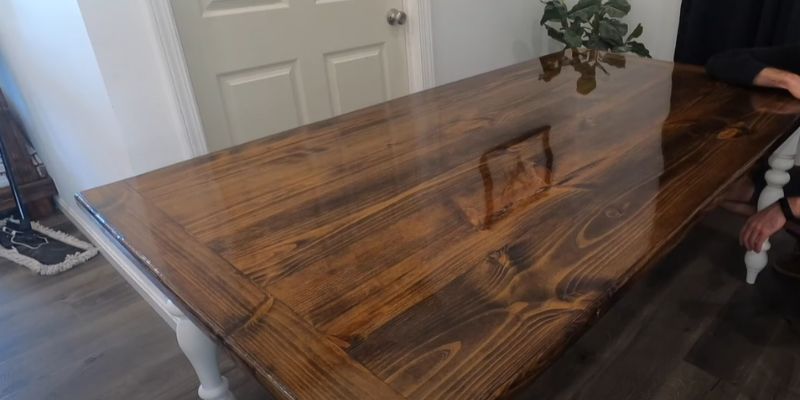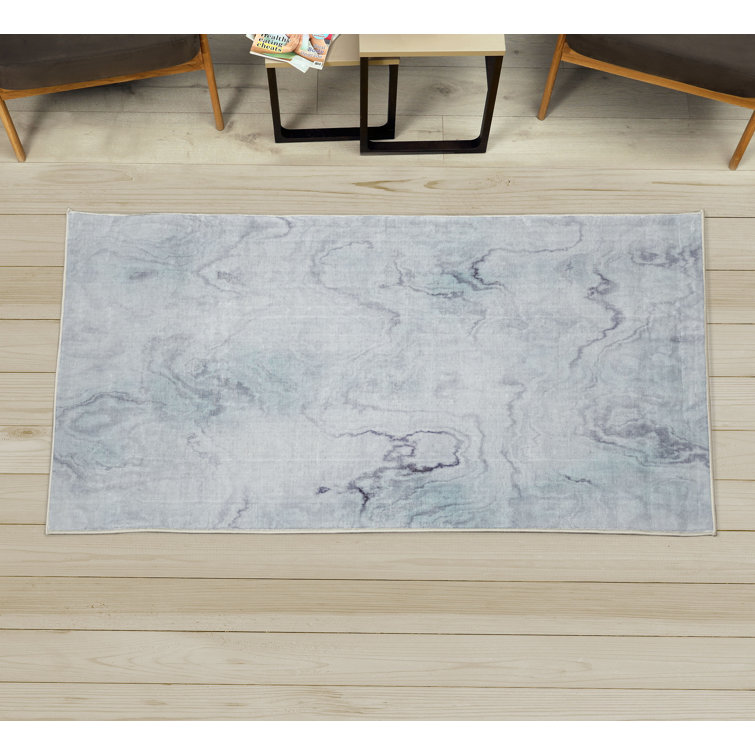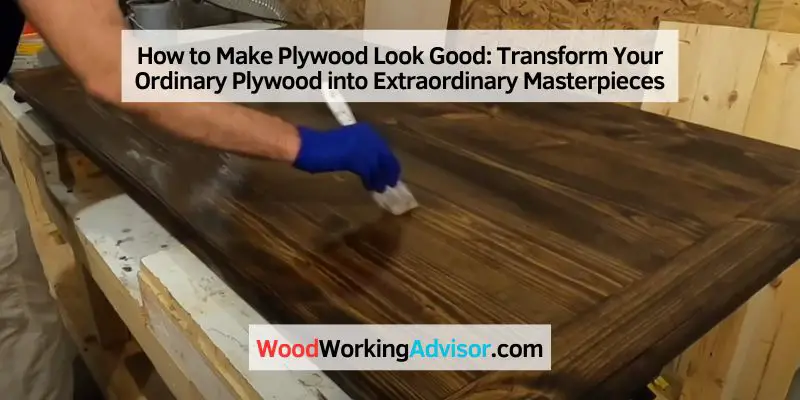To make plywood look good, follow these simple steps: sand the surface smooth, apply a primer, and finish it with a high-quality paint or stain.
Choosing The Right Plywood
Selecting the right plywood is crucial when it comes to enhancing the overall appearance of your furniture or home decor projects. With a variety of grades and wood species available in the market, it’s important to make an informed decision to achieve the desired look.
Selecting The Right Grade
The grade of plywood determines its appearance and suitability for different applications. Here are a few popular grades to consider:
- A Grade Plywood: This is the highest quality plywood with a smooth, consistent surface and minimal defects. It is ideal for projects where visual appeal is paramount, such as cabinets or furniture pieces that require staining or clear finishes.
- B Grade Plywood: This grade has a slightly lower quality than A grade. It may have more visible variations in color and texture, making it suitable for projects where appearance is important but not crucial, such as shelving or non-exposed areas.
- C Grade Plywood: C grade plywood contains more visible defects and knots, making it suitable for projects where appearance is not a primary concern, such as structural or outdoor applications.
Considering The Wood Species
The wood species used to make plywood can greatly impact its aesthetic appeal and durability. Here are a few common wood species to consider:
- Hardwood Plywood: Made from hardwood veneers, this type of plywood offers a natural, timeless beauty. It is widely used in high-end furniture and cabinetry due to its durability and attractive grain patterns.
- Softwood Plywood: Softwood plywood, like pine or fir, is less expensive than hardwood plywood. It is suitable for projects where appearance is not a primary concern, such as subflooring or sheathing.
- Exotic Plywood: If you’re looking for a unique and eye-catching appearance, consider using exotic plywood, such as mahogany or teak. These wood species offer rich colors and distinctive grain patterns, perfect for creating focal points in your projects.

Preparing The Surface
Before you begin transforming your plywood into a stunning piece of decor, it is crucial to properly prepare the surface. By taking the time to sand the plywood and fill imperfections, you can achieve a smooth and flawless finish. In this section, we will guide you through the steps involved in preparing the surface of your plywood.
Sanding The Plywood
One of the first steps in preparing your plywood is to sand it thoroughly. Sanding helps to create a smooth surface by removing any rough edges, splinters, or uneven spots. To sand the plywood effectively, follow these simple steps:
- Start with a coarse-grit sandpaper (around 80-100 grit) to eliminate any major imperfections.
- Hold the sandpaper firmly and move it in a circular motion, working along the grain of the wood.
- Continue sanding until the plywood feels smooth and all rough areas have been evened out.
- Switch to a finer-grit sandpaper (around 120-150 grit) to further refine the surface. Repeat the circular motion, ensuring a consistent finish.
- After sanding, wipe away any dust using a clean cloth or a tack cloth specifically designed for removing particles.
Filling Imperfections
To achieve a flawless look, it is essential to fill any imperfections present on the plywood surface. Filling imperfections helps to create an even canvas for painting, staining, or varnishing. Here are the steps to follow when filling imperfections:
- Inspect the plywood closely for any cracks, knots, or holes that need to be filled.
- Choose an appropriate wood filler or putty that matches the color of your plywood.
- Apply the filler using a putty knife, filling each imperfection and smoothing it evenly across the surface.
- Allow the filler to dry completely based on the manufacturer’s instructions.
- Once dry, use a fine-grit sandpaper to gently sand the filled areas, ensuring they blend seamlessly with the plywood surface.
- Wipe away any dust with a clean cloth before proceeding.
By following these steps, you can ensure that your plywood surface is adequately prepared for the next stage of finishing, whether you choose to paint, stain, or varnish it. Taking the time to prepare the surface will not only make your plywood look good but also enhance the overall durability and longevity of your project.
Creative Finishing Techniques
Plywood is a versatile and cost-effective material that can be transformed into a stunning centerpiece of any space with the right finishing techniques. By applying creative finishing techniques, you can enhance the natural beauty of plywood and achieve a customized look to suit your design aesthetic. From staining and dyeing to adding veneer or laminate, there are various methods to make plywood look good.
Staining And Dyeing
Staining and dyeing are effective methods to enhance the natural grain and color of plywood. By choosing the right stain or dye, you can achieve a rich, deep hue that complements the surrounding decor. Ensure the plywood surface is clean and smooth before applying the stain or dye to ensure even absorption and a flawless finish.
Adding Veneer Or Laminate
Veneer or laminate can be added to plywood to give a polished and luxurious appearance. Choose from a variety of wood veneers or laminate finishes to achieve the desired look. With careful application, the addition of veneer or laminate can provide durability and resistance to wear and tear, enhancing the overall aesthetic appeal of plywood.

Credit: www.wayfair.com
Innovative Plywood Applications
When it comes to home design, plywood is often overlooked as a material choice. However, with a little creativity and ingenuity, plywood can be transformed into a stunning feature in your space. In this blog post, we will explore two innovative applications of plywood that can elevate the look of your home: Creating Custom Furniture and Designing Accent Walls.
Creating Custom Furniture
One way to make plywood look good is by incorporating it into the creation of custom furniture. Plywood’s versatility and sturdiness make it an ideal material for designing unique and functional pieces that can become the centerpiece of any room. Whether you want to build a stylish dining table, a sleek bookshelf, or a trendy desk, plywood provides endless possibilities.
With plywood furniture, you have the freedom to design pieces that perfectly fit your style and needs. Plus, the natural beauty of wood grain adds warmth and character to your home. To ensure your plywood furniture looks its best, here are a few tips:
- Choose high-quality plywood: Opt for plywood with a smooth, even surface and minimal imperfections.
- Create a polished finish: Sand the plywood surface thoroughly and apply a protective finish to enhance its appearance and durability.
- Add unique touches: Incorporate creative elements like paint, stains, or decorative hardware to elevate the design.
Designing Accent Walls
Another innovative way to make plywood look good is by using it to design accent walls. An accent wall can instantly transform a room by adding texture, visual interest, and depth. Plywood, with its natural warmth and unique grain patterns, becomes an eye-catching feature when installed on a wall.
To create a stunning plywood accent wall, consider the following:
- Choose the right type of plywood: Select plywood with an attractive grain pattern that aligns with your design vision.
- Plan the layout: Determine the size and arrangement of plywood panels to create a visually pleasing pattern or design on the wall.
- Experiment with finishes: Consider painting or staining the plywood panels to enhance their visual appeal and coordinate with the overall color scheme of the room.
By utilizing plywood in these innovative ways, you can showcase its beauty and make it a standout element in your home. Whether you decide to create custom furniture or design an accent wall, plywood offers endless possibilities for adding style and personality to your space.
Maintenance And Protection
Maintenance and Protection are key to keeping plywood looking good and ensuring its longevity. By taking proper care of your plywood, you can prevent damage and enhance its appearance. This section will discuss two essential aspects of maintaining and protecting plywood: sealing the plywood and regular cleaning and care.
Sealing The Plywood
Sealing plywood is crucial to protect it from moisture and UV rays. Moisture can cause the plywood to warp or rot, while UV rays can fade its color. Here are some steps to follow when sealing your plywood:
- Clean the surface of the plywood thoroughly. Remove any dirt, dust, or debris using a soft brush or cloth.
- Fill any cracks or gaps in the plywood with wood filler. Smooth the surface using sandpaper.
- Apply a wood sealer or primer using a brush or roller. Ensure complete coverage and follow the manufacturer’s instructions for drying time.
- Once the sealer/primer is dry, sand the plywood lightly with fine-grit sandpaper to create a smooth finish.
- Apply a topcoat of paint, varnish, or polyurethane to protect the plywood. Choose a product suitable for outdoor or indoor use, depending on your plywood’s location.
- Allow the topcoat to dry completely before using or exposing the plywood to moisture or sunlight.
Regular Cleaning And Care
To keep your plywood looking its best, regular cleaning and care are vital. Follow these guidelines for proper maintenance:
- Remove any spills or stains immediately using a damp cloth or sponge. Avoid using harsh chemicals or abrasive cleaners that can damage the plywood surface.
- Dust the plywood regularly using a soft cloth or duster to prevent the buildup of dirt and debris.
- Periodically clean the plywood with mild soap and water. Use a soft brush or sponge to gently scrub the surface, then rinse with clean water.
- Avoid placing hot objects directly on the plywood surface, as it can cause discoloration or damage.
- Consider using furniture pads or coasters under heavy objects to prevent scratches or dents.
- Inspect the plywood regularly for any signs of damage, such as cracks or splintering, and address them promptly to avoid further deterioration.
By sealing your plywood and implementing regular cleaning and care routines, you can maintain its appearance and protect it from damage. These simple steps will enhance the lifespan of your plywood and ensure it continues to look good for years to come.
Frequently Asked Questions Of How To Make Plywood Look Good
How Do You Beautify Plywood?
To beautify plywood, consider sanding the surface, applying a wood conditioner, staining, and sealing with varnish or polyurethane for a polished finish. You can also opt for painting or decoupage to add a decorative touch. Use quality materials and follow proper techniques for best results.
How Can The Appearance Of Plywood Be Improved?
To improve the appearance of plywood, you can choose to paint or stain it. This will enhance its aesthetic appeal and help it blend better with the surroundings. Additionally, applying a clear varnish or coating can also give plywood a smoother and more polished look.
How Do You Make Plywood Ends Look Good?
To make plywood ends look good, consider using edge banding or veneer tape to cover the exposed edges. You can also sand the edges smooth and apply a suitable finish, like paint or stain, to match the surface. Adding a decorative trim or molding can further enhance the appearance.
How Do You Make Plywood Look Like Veneer?
To make plywood look like veneer, apply a thin layer of real wood veneer to the plywood surface. Ensure the veneer is properly sanded, glued, and trimmed for a smooth, professional appearance. Sand and finish the veneer to achieve a natural, seamless look.
Conclusion
To sum up, transforming plywood into an aesthetically pleasing material is achievable through various methods. Whether it’s applying a decorative finish, adding veneers, or utilizing unique designs, there are countless ways to enhance its appearance. By incorporating these techniques, you can elevate the visual appeal of plywood and create stunning, customized pieces for any project.


